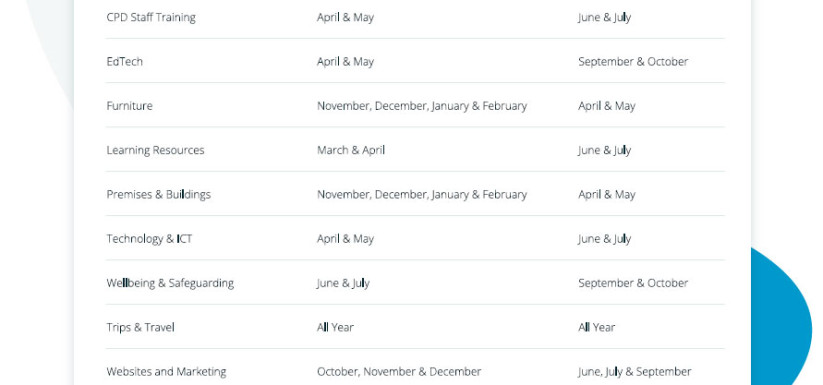How to Sell to Multi-Academy Trusts
How to Sell to Multi-Academy Trusts
Understand one of your businesses' ultimate decision-makers, and the key periods within the academic calendar to reach them with your edu-marketing.
Understand one of your businesses' ultimate decision-makers, and the key periods within the academic calendar to reach them with your edu-marketing.
Understanding who the ultimate decision maker is for your business’s product or service, and to what extent and by whom those decisions can be influenced, is one of the most pivotal questions underpinning your marketing strategy. It’s a question we’re asked several times every single day.
And nowhere is this question more complicated than in the Academy sector. Who is it that you really need to focus your marketing efforts on – the Multi-Academy Trusts (MATs) or the individual Academies? And what are the key periods within the academic calendar when these decision makers are going to be most receptive to your messaging?
Combining the results of a survey of over 3,000 school staff with a series of private interviews with MAT CEOs, this report will start answering those questions and enable you to plan or refine your marketing strategy this year.
Multi-Academy Trusts and their budgets explained
Before we examine how the decision-making process works in MATs and Academies, we need to understand the basics. What is an Academy, where do they get their budgets from, and how are they shared across a Trust
What is an Academy?
Academies are independent state-funded schools that receive their funding directly from the central government as opposed to via their local authority like most state schools.
There are two types of Academies;** Sponsored Academies**, which are typically underperforming schools that convert to an Academy with the involvement of an outside sponsor, and Converter Academies, which are schools that have been rated ‘Good’ or ‘Outstanding’ and choose to convert to an Academy themselves.
How many Academy schools are there in the UK?
There are currently just over 8,300 Academies in England (the Academy model has not been adopted by other parts of the UK) and of these around 5,900 are primary aged and around 2,400 are secondary aged.
All of these Academies are attached to one of the 1,170 Multi-Academy Trusts (MATs) that have been set up to date. Over half of these MATs manage five or less Academies, around a quarter manage between 6-11 Academies, while just over 100 manage 12 or more Academies.
What is a Multi-Academy Trust (MAT)?
A MAT is a group of Academies that come together to form a charitable company, with a group of Members who overview the governance arrangements and a single Board of Trustees who oversee all decision- making across the Trust. All staff within the MAT and its Academies are employed by the charitable company.
Individual Academies receive their funding directly from the Department for Education, the General Annual Grant (GAG) being the core funding element, and this is then shared across all the Academies belonging to the Trust according to a shared Academy Funding Agreement.
The key decision makers at Multi-Academy Trusts
Next, we need to understand who the key decision makers are within MATs and what their exact responsibilities are. In this section we’ve given a brief description of the staff types that make up a) the Executive Team, who are the ultimate decision makers at MAT level and the ones held accountable by the Board, and b) the Directors, who report to the Executive Team and are responsible for the strategic direction of the Trust in certain key areas.
Executive Team
CEO/Accounting Officer:
A CEO is the strategic lead of a Multi-Academy Trust, supervising all Head Teachers working within the Trust. They take full responsibility for all non-education outcomes, specifically the Academies’ finances and budgets, and the operational growth of the Trust.
Chief Financial Officer (CFO):
All MATs must have a named Chief Financial Officer to oversee all financial matters for the Trust and ensure compliance. Reporting directly to the CEO, they will ultimately be responsible for proper financial conduct, provide advice on strategic financial issues, and manage the leadership of the finance team.
Chief Operations Officer (COO):
The Chief Operations Officer oversees the management of all non-academic aspects of the Trust. Forming part of the Executive Team, they’ll work closely with Trustees and Principles of the Academies, and will usually take head responsibility for HR, IT, Premises, and Marketing projects.
Executive Headteacher:
The Executive Headteacher is the strategic leader of all Academies in the Trust, overseeing improvement, growth, and partnerships. They’ll ensure the highest standards of education, learning, and achievement, working closely with the Trustees and Executive team. They will also hold responsibility for managing the Trust, with a hand in recruitment, HR, and finances.
Business Manager:
The Business Manager supports the CFO and CEO with financial matters to ensure the Trust operates in good financial governance. They will typically have a hand in other areas, including recruitment, business development, HR, legal issues, and estates management, perhaps holding managerial responsibility of other administrative staff.
Directors
Director of Business:
The Director of Business will work across the MAT with all Academies and be responsible for the financial, human, and physical resources of the Trust, as well as playing a role in supporting the Trust’s strategic planning. They will work closely with the CFO to oversee financial matters.
Director of Data, Information & Systems:
This staff member holds the responsibility for creating and maintaining effective IT systems and data management processes, typically to assist with record-keeping and holding assessment data. They may also assist the Director of ICT and Network Managers to establish sound IT and EdTech for classroom use.
Director of Education & Teaching:
The Director of Education and Teaching will be responsible for the support, training, and management of the leadership teams across all Academies. Their focus is on helping these teams achieve the best outcomes for students spiritually, morally, socially, and academically.
Director of Estates:
The Director of Estates oversees the site management, cleaning, and catering of all Academies to ensure high levels of health and safety, learning, and development. They’ll manage any premises and building improvement projects, supervising Academy site staff and external contractors. They will typically be in charge of sourcing and securing funding sources for estate projects.
Director of HR:
The Director of HR is responsible for all staff personnel issues related to improving satisfaction and wellbeing, leading to a better quality of learning and development. They may assist with recruitment and development, reviewing Academy performance, and monitoring compliance.
Director of ICT:
The Trust’s Director of ICT leads the IT provision across the Trust, working with each Academy’s IT and Computing staff to provide the equipment and software needed to meet their aims and objectives. They are in charge of developing and maintaining all technology initiatives.
Director of Leadership:
This staff member will be responsible for the development and implementation of personal and professional leadership development strategies for staff members across the Trust. This typically includes holding or sourcing coaching sessions, evaluating staff performance, and ensuring continuous development is made to support high levels of teaching and delivery.
Director of Pastoral Care:
It is the duty of the Director of Pastoral Care to develop and sustain a healthy environment to protect the welfare of every pupil and staff member in their Academies. They lead a wider team of pastoral staff to develop strategies for interventions, positive behaviour, and increased attendance.
Director of Safeguarding:
The Director of Safeguarding takes the lead role of child protection across all Academies in the Trust. Working closely with designated safeguarding persons, they oversee the development of new policies, maintain accurate and secure records, and assist Academies and external parties with severe or difficult safeguarding concerns and referrals.
Director of Safeguarding, Behaviour & Welfare:
Similar to the Director of Safeguarding, this role involves taking responsibility for student safeguarding, but has further responsibilities in student behaviour and welfare. Tasks include developing strategies to maintain Academy-wide standards and managing student referrals. Understanding the roles and responsibilities of these key staff types is fundamental to planning your segmentation and content strategy.
Multi-Academy Trusts’ key purchasing periods
Once you understand who the key MAT decision makers are for your product or service, the next step is to plan the key periods when your marketing will have maximum impact. This doesn’t just mean knowing when purchasing decisions are likely to be made, but also when key strategic planning conversations are taking place.
Is there a general rule for when MATs and Academies make purchasing decisions?
No. It will vary from one MAT to another even though all Academies receive their annual budgets in September. However, from our own research and interviews conducted with MAT CEOs we’ve been able to put together the following table highlighting the key periods when MATs are either assessing need and investigating potential solutions, or making purchasing decisions:

Do MATs make purchases outside of these key periods?
Absolutely. In almost all of the above areas, MATs withhold a certain portion of their budget to spend on a more ad hoc basis throughout the year. However, these will be smaller items of expenditure requiring shorter lead times for decision making.
Are there any other key dates that might determine when decisions are made?
Yes, there are several other funding streams throughout the year that can impact when purchasing decisions are made:
Pupil Premium Instalments:
Academies receive Pupil Premium funding instalments in October, January, April, and July. These are targeted at boosting attainment for more disadvantaged pupils.
Sports Premium Instalments:
Primary Academies receive Sports Premium funding instalments in November, February, and May, and this money is ring-fenced for improving the quality of PE and sporting activities they offer their pupils.
Condition Improvement Fund / School Condition Allocation:
MATs submit their application for the Condition Improvement Fund (CIF) or the School Condition Allocation (SCA) in December. CIF is open to MATs with less than five Academies and SCA is open to MATs with five Academies or more. These budgets are created by the government to help keep academic buildings in good condition.
Summer Capital Projects:
During June, July, and August MATs and their associated Academies will schedule capital projects such as building repair and refurbishment, expansion, and infrastructure. CIF and SCA funding will be used for these projects (as will the Salix Energy Efficiency Fund or SEEF), but most MATs will also withhold some of their General Annual Grant for these projects.
General Annual Grant (GAG):
In September, Academies receive their annual budgets and these are shared across the MAT as per the Trust’s shared Academy Funding Agreement.
Any marketing strategy to schools must ensure that you remain visible and at the forefront of teachers’ minds all through the year, so please don’t take from this that there are only a handful of key times when your emails will have an impact.
However, understanding when schools are planning and investigating solutions, and when they are making purchasing decisions, is crucial in tailoring your marketing content throughout the academic year.
Where decisions are made - Academy or MAT level?
When marketing to Academies and MATs, the million-dollar question is at what level the purchasing decisions are made. Is it at Academy level or MAT level? To understand that, we need to begin by looking back at how General Annual Grant (GAG) funding is shared across a Trust.
How are Academy budgets shared across a Trust?
The vast majority of MATs will top-slice the funding their individual Academies receive in order to fund their operational costs. The amount that is top-sliced varies but is usually less than 5%.
However, it’s estimated that around 11% of MATs engage in a process called GAG Pooling where they amalgamate a much larger proportion of their Academies’ funding into one consolidated GAG Pool.
The key advantage of GAG Pooling is that it gives MATs the freedom to allocate funds in such a way as to better achieve their strategic goals, enabling them to target funding to areas of greatest identified need. However, the relatively small number of MATs currently engaging in GAG Pooling suggests many Academies are resistant to a perceived loss of autonomy and control over their finances.
How much difference does GAG Pooling make to whether purchasing decisions are made at MAT level or Academy level?
Based on interviews with MAT CEOs and our recent survey of over 3,000 school staff, we’ve created the following breakdown of where purchasing decisions are typically made for different sectors:

As you can see, the question of whether or not the MAT GAG Pools funding is absolutely key to deciding who the ultimate decision maker is likely to be. However, you also have to remember that only 11% of the 1,170 MATs currently GAG Pool, so that makes up a very small segment of your Academy audience.
The above breakdown is of course a simplification, as all MATs will work slightly differently. The most notable exception to the above chart would be SEN Schools within MATs as these would be given a lot more decision making power due to their more specialised requirements.
What are the key differences between purchasing processes at MAT level and Academy level?
Aside from the obvious fact that MATs can get economies of scale that help drive down the cost of items such as exercise books, paper and ICT, the most important difference is the level of purchasing expertise held by MAT decision makers.
One of the key challenges for schools that we hear about time and again is how teachers and staff just don’t have the purchasing expertise needed to get the best value for their schools. However, when decisions are made at MAT level, they’re often being made by people with a background in tendering and procurement.
Purchasing is almost certain to be more formalised, with the majority of purchases over £5k going through some sort of tendering process (for example, at least two quotations for over £5k, three quotes for over £10k).
Even if decisions are made at MAT level, how much influence can Academies have on the choice of suppliers?
A lot. Not only do most MATs hold fortnightly sessions with all Academy Head Teachers, but they also hold regular, often weekly, one-to-ones where the Head Teacher can share ideas. This can often include showcasing potential solutions provided by external suppliers not on the MAT’s approved supplier list.
If an Academy Head Teacher does put forward such a recommendation it will then be evaluated by the central team before being added to the MAT’s preferred list of suppliers. At this point, the Academy can order from them if the value is below the threshold set for tendering.
MAT CEOs have told us that new solutions and suppliers are often “trialled” at a single Academy before a decision is made on whether to roll it out Trust-wide.
How to win more business from MATs and Academies
Based on the key findings of this report, I’ve summarised what I believe to be the top 5 key takeaway tips for your business as you look to optimise your marketing and sales to MATs this year:
1. Don’t focus solely on marketing to MATs.
Even if the decision making power for your product or service ultimately resides with the MAT Executive Team, purchasing decisions can almost always be influenced by the individual Academy leaders. If your solution or product is particularly innovative, it may actually prove more effective to prove the concept in a single Academy before working to upscale the roll-out across the MAT.
2. Tailor the marketing you send to MAT Leaders.
The CEO, COO, and CFO are the key people for decisions made at MAT level and the marketing you send to them needs to talk about the scalability of your product or service and what economies of scale are available for rolling it out across the Trust. While shouting about discounts and offers often fails to register with Academy staff, it came up time and again as a key factor in our MAT CEO interviews.
When communicating with individual Academy leaders, try to send them an information pack that covers these points so that they can share with MAT decision makers (who will always want to be assured that what you offer is scalable, even if it is only to be trialled in a single Academy initially).
3. If you only target your marketing at purchasing periods, it’s already too late.
One thing that’s become apparent while researching this report is that although MATs make purchasing decisions during specific key months, those decisions are made based on preparatory work done earlier in the year. So don’t just schedule your marketing during the periods when you usually see a rise in orders, focus on laying the groundwork during the months where MATs and Academies are identifying areas of need and investigating solutions.
4. Make it a priority to find out if the MAT GAG Pools or not.
Finding out if the MAT you’re dealing with is one of the 11% that currently GAG Pools their Academies’ funding should be a priority in order to ascertain where the bulk of the decision-making power resides. This information will then inform how important it is that you involve the MAT CEO, CFO, and COO early in your conversations.
5. Remember you’re dealing with people with extensive purchasing expertise.
The MAT Executive Team are likely to be very experienced in procurement so the purchasing process is likely to be far more formalised, requiring them to obtain three or more quotes for purchases over £5k and often a formal Tendering process beyond that.
Often suppliers will be invited by either the MAT or an individual Academy to submit a quote/proposal so it’s vital you stay visible with your marketing throughout the year so that you are considered when these opportunities arise. Then make sure that you learn about the tendering process and what you need to do to win more business from that channel.
How Sprint Education can help you connect with your audience
If you feel like you already have both the in-house marketing expertise and the right connections within MATs and Academies, then hopefully this report gives you the information you need to fine-tune your segmentation, content strategy, and timings for the year ahead. However, if you feel like you’re lacking in one or both of those areas, this is how Sprint Education can help.
Option A: Campus (Edu. Data, Marketing & Sales Software).
Campus provides you with all the education data you will need (including 80,000 average monthly updates) and an integrated emailing platform where our education-warmed IP addresses ensure the best possible open rates to teachers. Check out our Google Reviews to find out what our current Campus users are saying.
Option B: Managed Marketing Strategy
With a managed strategy, our expert team will manage the segmentation, strategy design, timings and content for you, so all you need to do is focus on converting the leads that our emails generate for you. Check out our case studies here to find out more.
How big is your potential audience within MATs and Academies?
There are over 250,000 named MAT and Academy staff in the Sprint Education database, including these key decision makers:
CEO/Accounting Officers: 1,311 Chief Financial Officers (CFO): 959 Directors of Business: 80 Directors of Data, Information & Systems: 62 Directors of Education & Teaching: 91 Directors of Estates: 155 Directors of HR: 203 Directors of ICT: 146 Directors of Leadership, Learning & Assessment: 225 Chief Operations Officers (COO): 172 Executive Headteachers: 1,622 Directors of Pastoral Care & Pastoral Leads: 2,588 Directors of Safeguarding, Behaviour & Welfare: 81 Academy Head Teachers: 7,623 Academy Business Managers: 4,979 Governors: 12,881 Trustees: 34
What are the next steps?
Book a Discovery Call with one of our experts by emailing info@sprint-education.co.uk or calling 01684 297374 to discuss how we can either give you access to this data via our Campus software or manage an expert email strategy on your behalf.
Tags
Academy Schools List
Education Marketing
Emailing Schools
Marketing
Marketing to Schools
Similar Articles


VIDEO: Reductions and Restrictions - Cost of Living Special
Watch episode two of our new video series, in which we unpack how the cost of living crisis affects teaching, learning, and school spending.


14 Ways to Increase your Click-to-Open Rate
In this article, we’re going to look at the 14 most important actions you need to take with your next email design to improve your click-to-open rate.


Expert marketing to schools support and solutions
Expert marketing to schools solutions
Email Head Teachers, Teachers, and Staff Inboxes
Email teachers and staff inboxes
Sell More to UK and Global Schools and Colleges
Sell more to schools and colleges

































